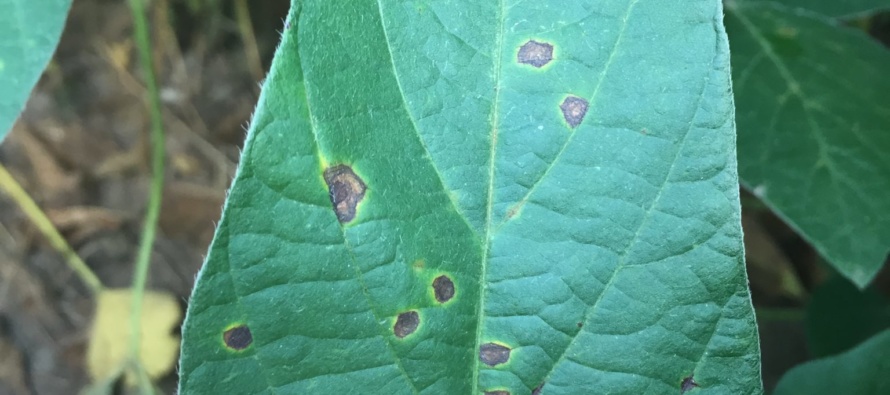Soybean Target Spot: Information Regarding Susceptible Varieties Observed During 2016

Related Articles
- 2010 Soybean And Corn Variety Trial Data 3
- Rice Variety Trial Results For 2010, Plus Rice Research Report 0
- Evaluation of Peanut Varieties in Mississippi, 2010 0
Latest Tweets
During 2016 one of the more common diseases in soybean throughout MS was target spot. Normally, target spot remains a mid-to-lower canopy disease. Target spot is one of the most common soybean diseases on an annual basis. However, given a conducive environment that generally consists of extended periods of wet, warm weather and a plant canopy that stays saturated throughout the day, target spot was observed to be much more aggressive during 2016 than in the past.
Following the severe target spot epidemic of 2016, several varieties were observed to be more susceptible to the disease. Some of the varieties were discontinued for the 2017 season; however, in the last week I have received at least one phone call regarding one of the varieties (Croplan 4752S) and severe (>70%) defoliation throughout the mid-canopy. In general, target spot defoliates leaves in the lower plant canopy that become infected. However, susceptible varieties can be observed to contain the disease in all plant parts. Symptoms on leaf tissue are normally easy to distinguish from other foliar soybean diseases, such as frogeye leaf spot. But, in situations where susceptible varieties are planted the symptoms that occur on plants can become difficult to distinguish from numerous other foliar diseases.

Target spot symptoms as observed on susceptible varieties. See text at right for explanation of each symptom.
The symptom descriptions are based on the photos provided at left and presented in a clockwise order. Target spot symptoms, when the most mature lesions are present on leaves, tend to be ¼ to ½ an inch in diameter and oftentimes are surrounded with a faint yellow halo (see photo A). In severe situations and more specifically when susceptible varieties are planted (see list below) the lesions formed on leaf tissue can appear quite similar to frogeye leaf spot and are generally less than a ¼ inch in diameter (photo B). Sometimes the smaller lesions have faint yellow halos, but more often a yellow halo is not associated with this particular lesion type. Oval lesions on the main stem itself and lesions at the base of the internode where petioles attach to the main stem (photo C) can also be observed on susceptible varieties. In situations where all of the symptoms occur on susceptible varieties, severe defoliation can result when entire petioles are defoliated rather than just infected leaf tissue.
 Some of the varieties observed to contain severe target spot during 2016 were genetically identical to one another. The responses in the field following target spot infection were generally observed to include: severe leaf spotting; symptom expression on pods, petioles and stems; severe defoliation that may have also been the result of loss of entire petioles. All of the varieties on the list were either observed to have severe disease in commercial soybean fields or in MSU Official Variety Trial locations. Some of the varieties have been removed from commercial availability; however, it is possible that some of the varieties (e.g., Croplan 4752S) were available for sale and are planted in the MS production system this season. At the very least, the three varieties highlighted with yellow boxes were not commercially available during 2017 based on information from the seed company.
Some of the varieties observed to contain severe target spot during 2016 were genetically identical to one another. The responses in the field following target spot infection were generally observed to include: severe leaf spotting; symptom expression on pods, petioles and stems; severe defoliation that may have also been the result of loss of entire petioles. All of the varieties on the list were either observed to have severe disease in commercial soybean fields or in MSU Official Variety Trial locations. Some of the varieties have been removed from commercial availability; however, it is possible that some of the varieties (e.g., Croplan 4752S) were available for sale and are planted in the MS production system this season. At the very least, the three varieties highlighted with yellow boxes were not commercially available during 2017 based on information from the seed company.
Monitoring fields that may contain one of these varieties is important. However, be mindful that unless a conducive environment has occurred the disease will not be present.




Let me tell You a sad story ! There are no comments yet, but You can be first one to comment this article.
Write a comment